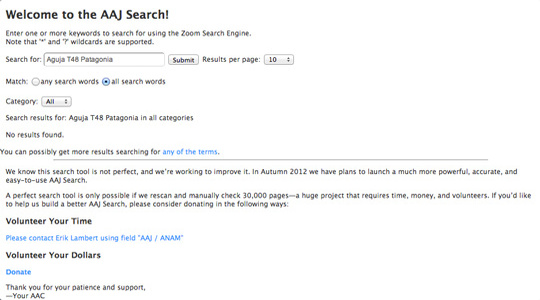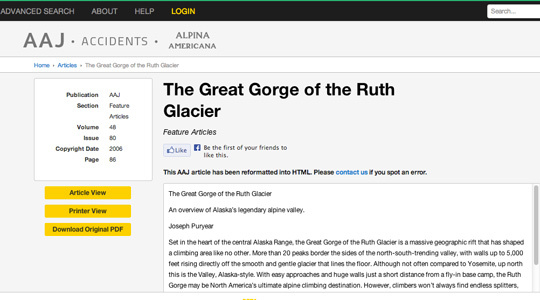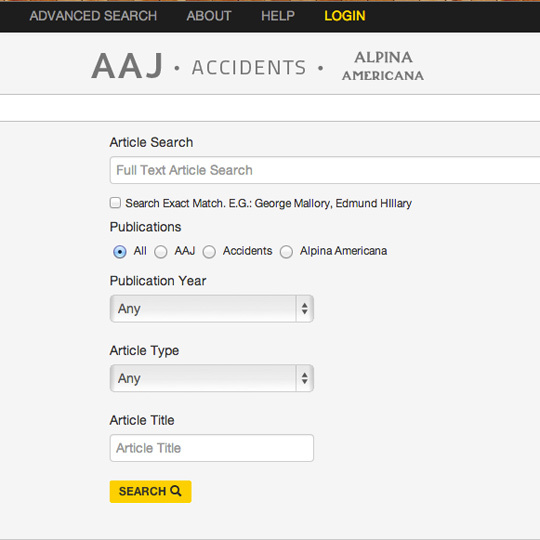For years, an Alpinist intern’s introduction to the online search function of the American Alpine Journal online archives took a good 10-15 minutes. It included small tips about search terms: Don’t bother searching for the year a particular ascent happened–it won’t get you any further. Only searching for the name of the peak will probably pull up too many results to be useful, including loads of one one-word references in the indices. If you don’t select ‘Match all search words,’ you’ll never what you’re looking for. Among other quirks, the search function sometimes gave you a PDF file with a dozen extra pages surrounding the information you actually wanted. Most vexatious was number of AAJ pages lost in the database, nearly inaccessible because they were uploaded with no underlying text layers.
After struggling with the old AAJ search for years, frequently turning up “no results” while looking for articles known to exist, Alpinist editorial staff abandoned the search function. A Journal editor took pity and uploaded 70 years worth of digital AAJs to the Alpinist server for research. Editors and interns then used a massive index of most of the AAJ volumes (now buried on the AAC website) to sift through the information, rather than using the online search.
But despite the AAJ search’s several follies, it remained an invaluable tool for Alpinist‘s print and online editors. Accruing the Journal‘s collection of firsthand accounts of a particular peak or range is one of the first steps in researching many of our exhaustive Mountain Profiles for the print magazine; there’s good reason The American Alpine Journal appears on the “Additional Thanks” list of almost every issue since Alpinist 30.

The former Alpinist.com editor turned American Alpine Club Information and Marketing Director, Erik Lambert, called the Alpinist office in Vermont yesterday with–for us climbing history dorks–exciting news: the AAC is launching a more searchable and complete digital archive of The American Alpine Journal within its larger Publications database. (Accidents in North American Mountaineering and the AAJ‘s short-lived predecessor, Alpina Americana, are also available in digital format for the first time.) More than 31,000 pages of digital content have been made available to members and nonmembers of the AAC alike. And, using the Advanced Search, these digital archives are searchable by year, page number, article type and title. (We are also told searches by location and by route are on the way.) Once the database is fully functional, climbers should be able to quickly gather information about every route that the AAJ has reported on a given peak, providing useful pre-trip beta and preventing second first ascents.

It seems many of the online AAJ search’s idiosyncrasies have been resolved in the beta site for the new database–and, Lambert says, more bugs will be worked out in the coming weeks. While typing in the year of the ascent you’re looking for will still do little to narrow your search results, those results are much easier to weed out than before because of the easy-to-interpret spreadsheet organization. And because the digital files have been cataloged in HTML format they take much less time to load than the previous version’s automatic PDF download. (The original scanned PDFs are still available to download, however).

The most noticeable upgrade is the clean design on the homepage, Advanced Search screen and results pages that users will find much more appealing and navigable than the old format. Habitual AAJ database users like ourselves may be frustrated when conducting very specific queries within one of the three publications by the number of clicks between typing in desired search terms to calibrating the Advanced Search to finally reading the Journal entry–especially if you want to take the extra step to download the PDF with photos and formatting. When I inevitably bookmark the new AAJ database for weekly research, I’ll link directly to the more useful Advanced Search page rather than the simple search on the homepage.

In all, the Club’s new publications database will serve as a magnificent improvement over its finicky and frustrating predecessor. Users will find more of what they’re looking for, and less of what they’re not–presented in clean, readable format. There are just a few deficiencies left to navigate, but the new AAJ search orientation will be much shorter for future Alpinist interns.
Pros: Clean design; Accidents in North American Mountaineering newly digitized; more search options; quicker article load time; HTML format yields more specific and accurate results; both HTML and PDF formats available.
Cons: Specific searches require more clicks than old version; automatically loading HTML format has no photos or text formatting (yet).